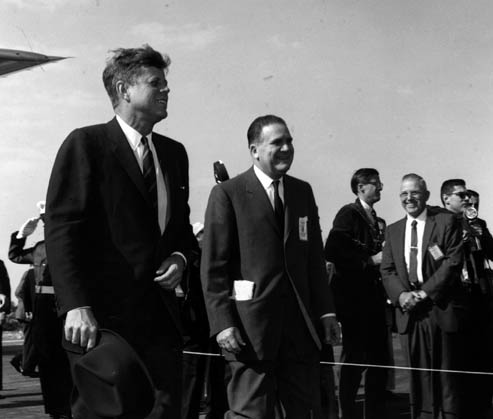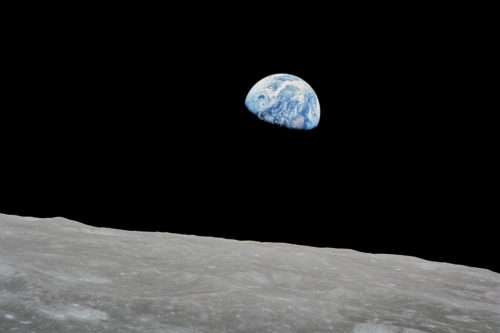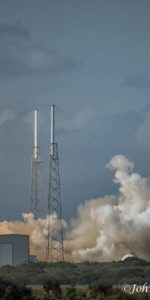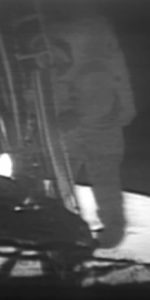
When we think of heroes in the early Space Age, our minds are naturally drawn to the likes of Yuri Gagarin and Alan Shepard, to Alexei Leonov and John Glenn, to Valentina Tereshkova and Neil Armstrong, and to Sergei Korolev and Wernher von Braun. These brave souls, and thousands like them, charted our first course away from Earth and allowed us to see new sights and visit new worlds. Their sacrifice remains incalculable, but one other man enabled the single step to be taken which may define us, centuries from now. Fifty-five years ago, last week, John Fitzgerald Kennedy—35th President of the United States—gave the speech to Congress which provided the political direction for America to land a man on the Moon. His actions, to be fair, were deep-rooted in the politics of his time, but their long-term ramifications have turned him into a hero of the Space Age.
Before Project Mercury inaugurated the United States’ dreams of placing humans into space, the idea of a piloted lunar landing was not firmly on the table. Instead, a series if committees and briefings in 1960—featuring then-NASA Administrator Keith Glennan and his deputy, Hugh Dryden—had considered a range of options, culminating in a circumlunar voyage by the follow-on Apollo spacecraft. In the words of George Low, who went on to head the Apollo Spacecraft Program Office and subsequently served as acting administrator of the space agency in 1970, a lunar landing “was a step which was too far beyond what we were willing to talk about at that time.”

However, according to Low—and quoted via interviews later published in Before This Decade is Out, edited by Glen Swanson—there were follow-on plans for lunar landings. “We had planned a program that, within this decade [the 1960s], would lead to a circumlunar flight,” Low explained. “Beyond this decade, Apollo would eventually lead to a lunar landing and to planetary exploration. We also proposed that, within this decade, Apollo could lead to, or could become part of, the space station program.” That said, by the fall of 1960, serious internal discussions about the possibility of piloted lunar landings were underway, including the establishment of ground rules for such missions, reasonable spacecraft weights, and launch vehicle requirements. A full day of briefings about a lunar landing program was presented to NASA’s Space Exploration Council on 5 January 1961, only days before John F. Kennedy was sworn into office. At the time, of course, Glennan was operating within the final days of Dwight D. Eisenhower’s administration, which had determined that there would be no major emphasis on manned spaceflights after Project Mercury.
Sworn in as president on 20 January 1961, after a long-fought campaign with Richard M. Nixon, one of Kennedy’s immediate goals was to address a perceived “gap” in missile-building technology between the United States and the Soviet Union. Both nations were racing to put a man in space—America through Project Mercury and Russia through its Vostok program—and the stakes were high. The success of Yuri Gagarin’s orbital mission on 12 April left Kennedy with the urgent need to do something to restore his nation’s credibility and technological muscle. A suborbital Mercury flight was almost ready to go, but an orbital mission was not expected until at least the end of 1961, and a CIA-backed attempt by a group of Cuban exiles to topple Fidel Castro at the Bay of Pigs collapsed in catastrophic fashion and proved hugely embarrassing for the United States.
Although he admitted responsibility for the bungled invasion, on 20 April Kennedy refined his plans to draw the Soviets into a space race and perhaps gain more credibility for his government. “Is there any space program,” he asked Vice-President Lyndon Johnson in one of the 20th century’s most influential memos, “that promises dramatic results in which we could win? Do we have a chance of beating the Soviets by putting a laboratory in space or a trip around the Moon or by a rocket to land on the Moon or by a rocket to go to the Moon and back with a man?” His motives, of course, were chiefly political, but Kennedy was clearly pinning his colors to the space flag.
Already, in the opening months of his administration, efforts within NASA had gained ground on the idea of a manned lunar landing. In February 1961, a Manned Lunar Program Planning Group—headed by Low—presented a position paper to NASA Associate Administrator Robert Seamans. By the middle of that month, Jim Webb was sworn-in as the new NASA Administrator, and, in March, he and Kennedy held a series of budgetary discussions. These focused on a number of ways in which the agency would accelerate the space program, including the speeding-up of studies of manned re-entries at lunar-return velocities, expediting technology development for missions to the Moon, and the development of propellants and engines for the powerful Nova rocket.

At the time of Gagarin’s mission on 12 April, Low, Dryden, Seamans and recently-appointed NASA Administrator Jim Webb were at hearings before the House Committee on Science and Aeronautics. At one stage, Rep. David King of Utah noted claims that the Soviet Union was planning to land cosmonauts on the Moon in 1967, on the 50th anniversary of the Bolshevik Revolution. King asked Seamans if the United States could similarly achieve this date. Under pressure, Seamans responded that landing an American on the Moon by 1967 might well be achievable.
The national fright induced by Gagarin’s mission, coupled with the Bay of Pigs fiasco, clearly prompted dramatic steps. One of the main personalities approached by Lyndon Johnson as he weighed up the options was the famed rocket designer Wernher von Braun, who, in a 29 April memo, felt that the “sporting chance” of sending a three-man crew around the Moon before the Soviets was higher than putting an orbital laboratory aloft. Others, including Secretary of Defense Robert McNamara, even pushed for a landing on Mars, although his motivations for such a proposal have been questioned. Von Braun, who had designed Nazi Germany’s infamous V-2 missile before coming to the United States in 1945 as a key player in its rocketry and space programs, felt that a lunar landing was the best option, since “a performance jump by a factor of ten over their present rockets is necessary to accomplish this feat. While today we do not have such a rocket, it is unlikely that the Soviets have it.”
The rocket to which von Braun alluded was “Saturn” and remained in the early planning stages, but a commitment to its development had been one of the conditions he had applied before agreeing to join NASA in October 1958. “With an all-out crash effort,” he told Johnson, “I think we could accomplish this objective in 1967-1968.” Von Braun’s judgment won the day for Johnson. Three weeks later, still smarting from Bay of Pigs humiliation, Kennedy delivered the speech which would truly define his presidency.
Several days later, on 5 May, Alan Shepard became America’s first man in space, completing a 15-minute suborbital mission aboard Freedom 7, which Soviet Premier Nikita Khrushchev ridiculed as a “flea hop” in comparison to Gagarin’s flight. In the aftermath, Kennedy wanted to talk of nothing but space, and some cynically speculated that his motivations centered upon beating the Soviets and overcoming the Bay of Pigs humiliation. However, when Shepard met the president shortly after the flight, he saw a true statesman and believed that the attraction of space exploration was very real for Kennedy. “He was really, really a space cadet,” Shepard told the NASA oral historian, years later, “and it’s too bad he could not have lived to see his promise.” Three weeks after Freedom 7, Kennedy nailed his colors to the space mast in one of the most rousing and inspiring addresses ever given in U.S. political history.
The second part of this article will appear tomorrow.
Want to keep up-to-date with all things space? Be sure to “Like” AmericaSpace on Facebook and follow us on Twitter: @AmericaSpace






I would like to here similar speeches from the candidates calling for a return to the Moon.
Basically stating:
Low Earth Orbit is a dead end we never should have retreated to after Apollo. Not only have we been there but we left long ago and made a fundamental error by returning. The Moon is the gateway to the solar system.
Mars is a useless destination and even if it was worth going to cannot be reached without massive shielding and nuclear energy. The Moon is the only place to acquire cosmic ray shielding, assemble, test, and launch nuclear missions to the outer solar system.
The Moon is the only destination that has resources to enable further exploration. The ice on the Moon is the critical resource enabling a permanent human presence Beyond Earth Orbit.
And of course, a completely funded Super Heavy Lift Vehicle program with LEO and associated programs abandoned. If the NewSpace concerns shift their focus to lunar landers they might stay in business.
Conway, you are correct in your assessment. Time to dust off the “Nova” booster specs and return to the moon. From there, we can develop the necessary technologies to go into deep space – be it Mars or beyond.
The Moon, and it many resources and opportunities, is going to be extremely valuable.
LEO and the International Space Station offer many useful options.
LEO has lower risks and costs than the Lunar surface.
LEO already has a National Laboratory for needed research at the International Space Station.
LEO has lower radiation levels than the Lunar surface.
The International Space Station in LEO is potentially accessible to more nations and companies than the Lunar surface.
National security and political issues mean the International Space Station in LEO will remain important.
A great nation like America with its many supportive nations, international businesses, and NGOs as partners can afford and should build, modify, and retain human bases and their related assets in LEO and on the Moon, Mars, and Ceres.
LEO is a dead end- a 4 billion dollar a year and climbing black hole. It should be abandoned. Period.
“‘Is there any space program,’ he asked Vice-President Lyndon Johnson in one of the 20th century’s most influential memos, ‘that promises dramatic results in which we could win? Do we have a chance of beating the Soviets by putting a laboratory in space or a trip around the Moon or by a rocket to land on the Moon or by a rocket to go to the Moon and back with a man?’ His motives, of course, were chiefly political, but Kennedy was clearly pinning his colors to the space flag.”
I recently heard someone on TV claim that it is going to take 1,000 trillion dollars to fully develop the planet Earth. That money won’t be spent in a year, or even two or three decades, but it will be spent. It is doable and the amount seems about right to me. Maybe it will be a lot cheaper, or maybe it will be more expensive. But if we want a peaceful world, it will be done.
As I have noted previously, I have spent a lot of time observing China make significant progress over the last thirty-two years and I know that we can develop the planet Earth. The only real question is how serious we are about getting that Earth development project done ASAP.
If we are not prepared to spend a few trillion dollars developing the Moon and more than that in developing Mars and Ceres, then perhaps folks should stop writing and talking about putting humans on the Moon, Mars, and Ceres.
We have the money. What we lack is wise political leadership.
Wise leaders would understand that the international development of Cislunar Space, which is legally defined to include the Moon, is needed to accelerate the development and maintain the security of the planet Earth.
If you cannot first note the hundreds of billions of dollars spent on the unneeded “black hole” of the world’s military budgets then commenting about a trivial “4 billion dollar a year and climbing black hole” of building peaceful scientific, technical, and political development at the International Space Station in LEO is completely illogical nonsense.
“World military expenditure in 2012 is estimated to have reached $1.756 trillion;
This is a 0.4 per cent decrease in real terms than in 2011 — the first fall since 1998;
The total is still higher than in any year between the end of World War II and 2010;
This corresponds to 2.5 per cent of world gross domestic product (GDP), or approximately $249 for each person in the world;” From: ‘World Military Spending’ By Anup Shah
At: http://www.globalissues.org/article/75/world-military-spending
We can avoid the immense costs of a Cold War II by the international development of LEO and the rest of Cislunar Space.
We also need to carefully defund and defang anyone who keeps on yapping about the wonderful and glorious benefits of internationally proliferating cheap ICBMs/launchers.
ARTICLE 2
General Description of the Space Station
2.1. NASA, RSA, the GOJ, ESA, and CSA will join their efforts, under the lead role of NASA for overall management and coordination, to create an integrated international Space Station (hereinafter “the Space Station”). NASA and RSA, drawing on their extensive experience in human space flight, will produce elements which serve as the foundation for the Space Station. The GOJ and ESA will produce elements that will significantly enhance the Space Station’s capabilities. CSA’s contribution will be an essential part of the Space Station.
2.2. The Space Station will be a unique permanently inhabited multi-use facility in low Earth orbit, with flight elements provided by all the partners and Space Station-unique ground elements to support the operation and utilization of the elements on orbit.
2.3. The Space Station will enable its users to take advantage of human ingenuity in connection with its low-gravity environment, the near-perfect vacuum of space and the vantage point for observing the Earth and the rest of the Universe. Specifically, the Space Station and its evolutionary additions could provide for a variety of capabilities, for example:
– a laboratory in space, for the conduct of science and applications and the development of new technologies;
– a permanent observatory in high-inclination orbit, from which to observe Earth, the Solar System and the rest of the Universe;
– a transportation node where payloads and vehicles are stationed, assembled, processed and deployed to their destination;
– a servicing capability from which payloads and vehicles are maintained, repaired, replenished and refurbished;
– an assembly capability from which large space structures and systems are assembled and verified;
– a research and technology capability in space, where the unique space environment enhances commercial opportunities and encourages commercial investment in space;
– a storage depot for consumables, payloads and spares; and
– a staging base for possible future missions, such as a permanent lunar base, a human mission to Mars, robotic planetary probes, a human mission to survey the asteroids, and a scientific and communications facility in geosynchronous orbit.
From: NASA-RSA Agreement MEMORANDUM OF UNDERSTANDING BETWEEN THE NATIONAL AERONAUTICS AND SPACE ADMINISTRATION OF THE UNITED STATES OF AMERICA AND THE RUSSIAN SPACE AGENCY CONCERNING COOPERATION ON THE CIVIL INTERNATIONAL SPACE STATION
http://www.nasa.gov/mission_pages/station/structure/elements/nasa_rsa.html